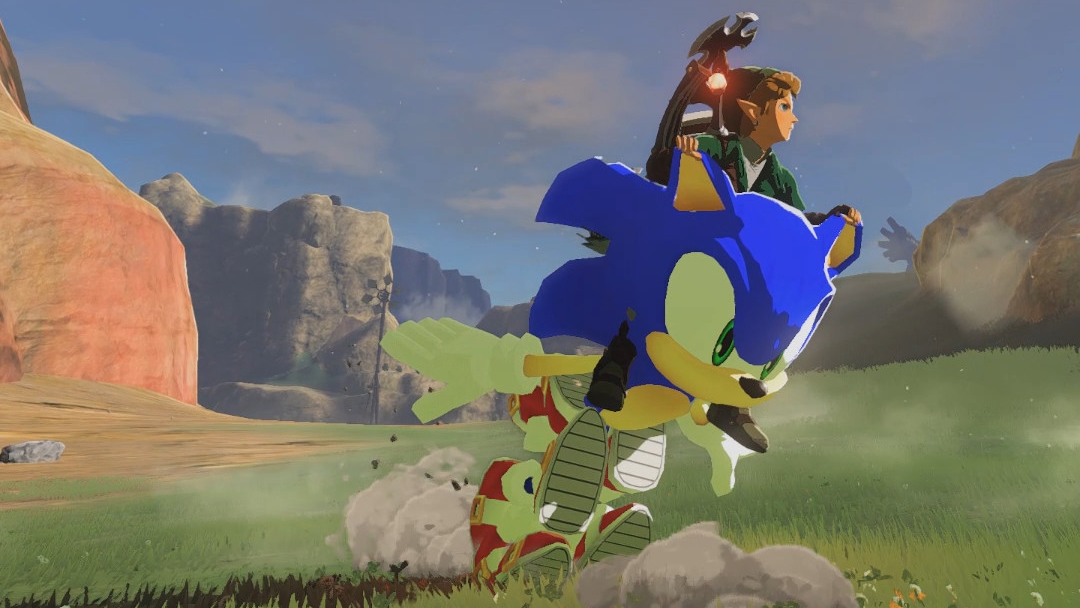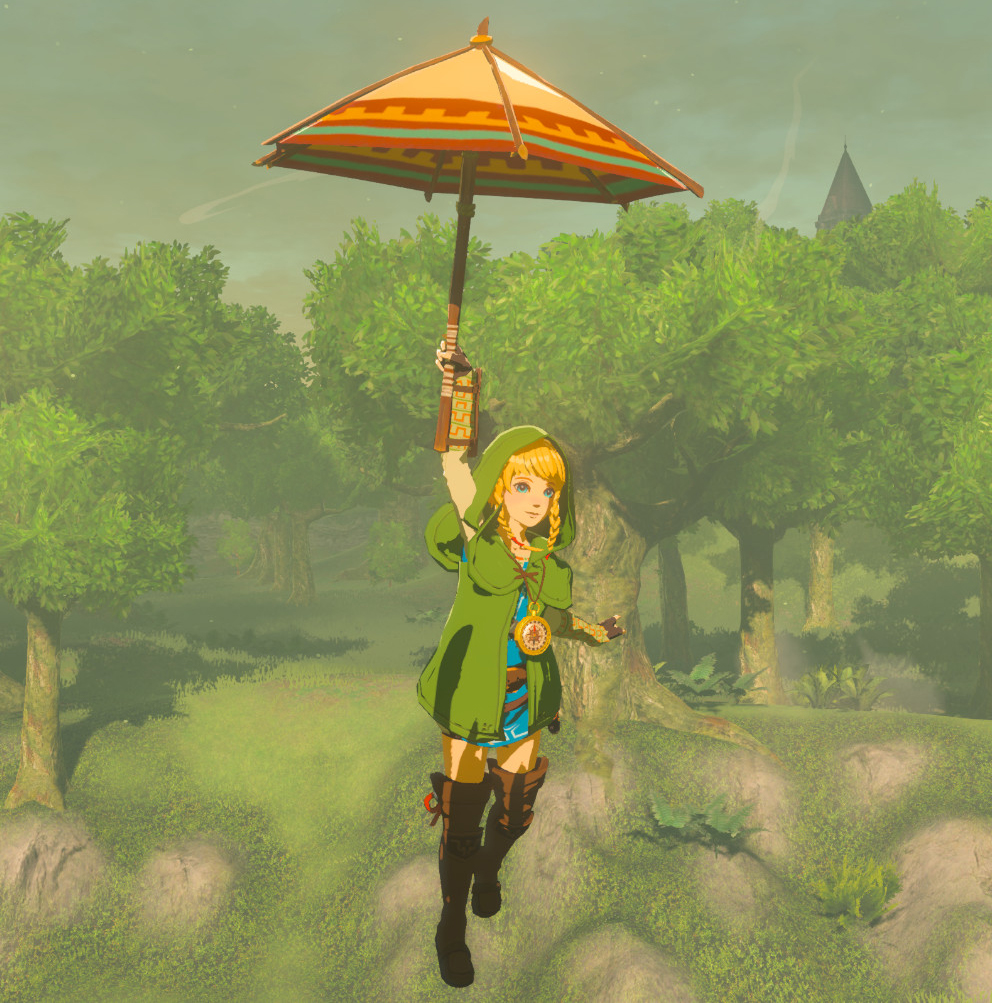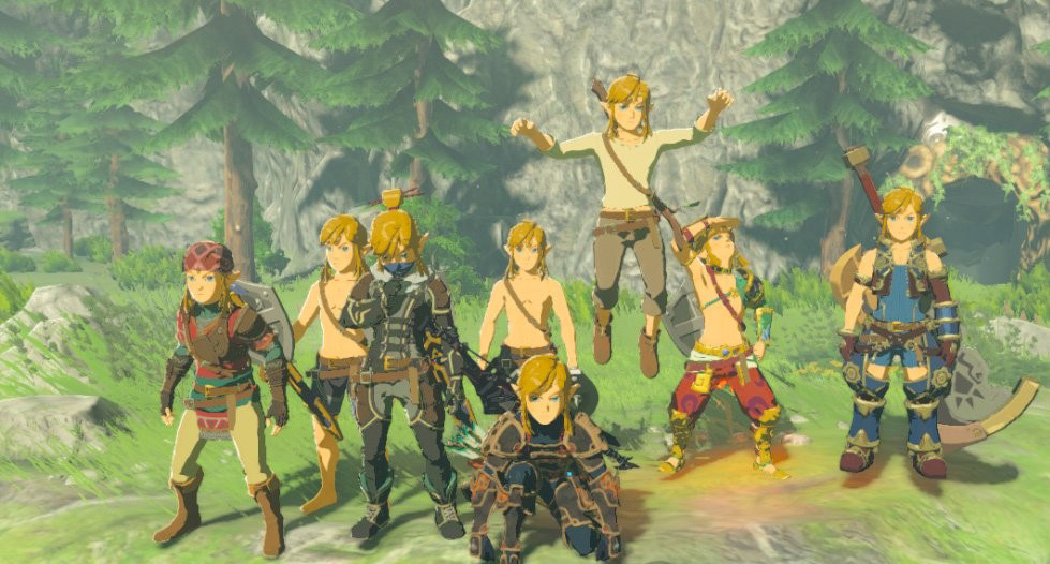
Sometime soon you'll be able to run around open world Hyrule, visit an entirely new village that wasn't in Nintendo's The Legend of Zelda: Breath of the Wild back in 2017, and delve into a newly unearthed crypt where a fresh boss fight awaits. And you'll be able to do all of that on PC. See, that village and crypt aren't in imminent Nintendo Switch sequel The Legend of Zelda: Tears of the Kingdom—they're from ambitious Breath of the Wild mod Second Wind, which has been in the works since 2020.
We've had the absolute fortune of running into every type of limitation that exists when it comes to modding BotW
Modder CEObrainz
In 2017, Breath of the Wild modders started with funny model replacements like Mario and GTA's CJ before moving to more ambitious projects, replacing full shrines with custom environments. By 2021 they were doing so much more.
"Initially Second Wind was meant to be an 'update' mod that added the ability to dye and upgrade all armours, do some minor rebalancing and feature a visually updated set of shrines," says mod dev lead CEObrainz. After some modding breakthroughs, Second Wind's original name—Breath of the Wild 2.0—no longer fit. "Things only changed once we learned how to add new objects to the game without replacing existing ones, as well as how to add new quests. With the realization that these things were possible the mod quickly grew."
Second Wind is just one of a few wildly impressive projects that transform or dramatically remix Breath of the Wild:
- Linkle 3.0, which completely replaces Link with female alter-ego Linkle, with custom animation, armor, and sound effects
- Dark Army Resurrection, a combat-focused mod that makes enemies tougher and spawns new breeds of skeletal baddies. Link gets a new skill system to compensate
- BOTW Randomizer, a comprehensive remix of enemies and items with a whole host of other random options, like suddenly changing the time of day or warping you across Hyrule
- Relics of the Past, a "super hard" mod that adds challenges across the map, revamps AI, loads you down with equipment and scales enemies alongside you
- Dangerous To Go Alone, a dizzyingly expansive (though still very unfinished) overhaul that aims to make combat feel like a Souls game, and also adds items from older Zelda games
There are rebalance mods, mods that let you play as Zelda, and, of course, mods that eliminate weapon durability. Some of these mods are built to work on original hardware, if you want to go through the effort of loading them onto a homebrewed console. But most are built for Cemu, the Wii U emulator that shot to widespread attention around the release of the game in 2017. Before helping birth a thriving mod scene, the volunteer developers behind Cemu had a more daunting challenge—just getting the game to work on PCs.
Hy(rule) stakes
"What makes Breath of the Wild tricky to emulate vs most other games is that it offloads some non-graphics tasks onto the GPU," says Cemu creator Exzap. "Having this kind of CPU <-> GPU interaction is hard to emulate correctly and most of the issues that you can see in the video, like Link sinking into the ground or water and grass not being rendered, were caused by it."
The video above (also on Streamable) is from a build of Cemu released on Patreon on March 10, 2017, just one week after Breath of the Wild debuted. After just a couple days of bugfixing, Exzap and other Cemu developers got Breath of the Wild to boot past the main menu without crashing. It still wasn't really playable, but that would soon change, and at a lightning pace. The interest from PC players was intense.
In January 2017, the Patreon for Cemu was worth around $4,000 monthly. By early April, it was pulling in $40,000, briefly making it the third biggest on the platform. That came with pressure to show progress in Breath of the Wild, and fast.
"We tried to make it understood that pledging was seen as a donation more than a promise to get anything in return," says Exzap. "Although we did have exclusive access to new releases a week in advance at that time. I am gracious for all the support we got, and still get, but there definitely was also a darker side to it when you have thousands of people impatiently complaining about the next update taking too long, especially since I take feedback a little bit too personal sometimes."

Exzap says that people tend to think of Cemu as the "Breath of the Wild emulator," and that association highlights the tricky position Cemu found itself in. Proper emulator development can't just focus on one game—that approach is likely to break compatibility with another. Exzap admits they prioritized BotW over other games "a little bit," but says after the first month or so of targeted bugfixes they were mostly focused on improving performance across Cemu.
"Unlike regular game development, it's really hard to predict what kind of progress you will be making and thus promises are hard to keep," they said. "Even worse, seemingly simple emulation bugs can turn into rabbit holes that take months to fix, which is in stark contrast to everyone wanting a bug fix or higher framerates as fast as possible."
Videos of Breath of the Wild's rapid improvement in Cemu made headlines in spring 2017, showing the game running (albeit slowly, or with glitches) at 4K. The breakthrough many were waiting for came in August, when a member of the Cemu community released a hack called FPS++ that unlocked the 30 fps frame limit. Optimizations eventually made it possible to run the game at 60 fps on PC, a night and day improvement over its erratic console framerate.
The arrival of a Vulkan driver brought with it a solution for notorious shader cache stutter, eliminating one of the last major issues. As the PC became a viable way to actually play Breath of the Wild rather than simply mess around with it, mods started rolling in. Exzap doesn't claim credit for the mod scene, though. Cemu didn't have support for game-specific game patches and graphics packs until a community-made plugin called Cemuhook arrived.
"The entire modding scene builds on this feature, although I have to say that this scene mostly emerged independent of us," Exzap says. "We tried to provide a framework for integrating mods into Cemu and the community found ways to make really cool stuff with it."
Link to the future
Prominent modder Waikuteru, who's made hundreds of videos on the game in addition to creating the BotW Randomizer, had no experience modding games until he tried some early Breath of the Wild mods and decided to create his own. He credits HailtoDodongo, who we first wrote about back in 2019, for breaking open map modding. Waikuteru's The Lost Records is one of several mods to add an entirely new shrine to Hyrule.
Even after five years, the mod scene isn't yet mature. Just a few months ago a modder released U-King Mod Manager, a replacement for an aging tool that helped players merge multiple mod installs without crashing their games. Another member of the community has been working on a decompilation project to fully decipher the game's code, which will likely take years if it's ever completed—we've only recently seen decompilations for the decades-old Mario 64 and Ocarina of Time.
The 'Panic Blood Moon' is a phenomenon where Breath of the Wild essentially resets the world state when it runs out of memory
Waikuteru, as well as CEObrainz, the lead modder behind Second Wind, say their work doesn't really require the insight from that decompilation. But there are still real challenges with modding the game, mostly as a result of the Wii U's weak hardware.
"We've had the absolute fortune of running into every type of limitation that exists when it comes to modding BotW," says CEObrainz. "Often, we are forced to completely rethink and redesign aspects of the mod to work around these limitations."
One of the most onerous is the "Panic Blood Moon," a phenomenon where Breath of the Wild essentially resets the world state when it runs out of memory. Adding too many unique items (like Second Wind's entirely new village) can trigger this overload.
Waikuteru says that the Panic Blood Moon "happens more often on the Wii U version, because the Wii U has worse components, such as only 2GB of RAM." The Switch, by comparison, has 4GB of RAM and far more CPU and GPU power. Second Wind, Waikuteru's mods, and a growing number of others are being released for both the Wii U and Switch versions of Breath of the Wild. In 2017 the Switch was too new to be emulated on PC, but a lot's changed in five years—Switch emulator Yuzu has caught up fast.
"BotW is fully playable on Yuzu, and there are only a few minor graphical issues that we're still working to resolve," says emulator lead Bunnei. "Compared to Yuzu, Cemu is generally faster and renders more accurately due to the maturity of the emulator and the lower specifications of the Wii U compared to the Switch. Additionally, Cemu boasts a more developed modding scene for BotW, including graphics packs that can significantly enhance the gameplay experience with features such as dynamic FPS, extended draw distances, and more."

Still, Yuzu is able to run Breath of the Wild at its native 30 fps on reasonable hardware: the emulator devs recommend a 10th gen Intel Core i5 or Ryzen 5 3600 and a GTX 1650 or Radeon RX 6500 graphics card. Hitting 60 fps requires top-of-the-line hardware, though, and if you drop frames the game will run in slow motion; FPS++ on Cemu delivers a better experience. But on Switch, things will only get better: Bunnei says they're currently "addressing some of the known graphical and performance issues that may affect BotW on Yuzu."
Every fan-made mod and line of emulator code written to make Breath of the Wild a better-looking, better-running, more interesting game on PC is, of course, done under Nintendo's disapproving gaze.
CEObrainz says the Second Wind team "adheres to strict guidelines" to only distribute mods as patches (rather than distributing any of Nintendo's code), avoiding piracy discussions in their Discord, and ensuring the mods can't be misconstrued as "official DLC."
Nintendo hasn't gone after popular modding sites like GameBanana to take down mods—the company could certainly make the case that the screenshots used to promote the mods are copyright infringing, but mod code itself is thornier. Mods shouldn't include any of Nintendo's proprietary code, but likely still violate the EULA (you know, that absurdly long document that says what you can and can't do with the software you just bought). Would a EULA saying "no mods plz" actually hold up in court, though? Hard to say. The answer will change from country-to-country, and Nintendo lost that battle once before in a 1992 case against the Game Genie.
Today, Nintendo's opting for the easier path—going after YouTubers to take down mod videos when they get too much attention. But with Switch emulation getting faster and Tears of the Kingdom on the horizon, it's hard to imagine those cases being more than a bump in the road for Zelda modders. There's about to be a whole new Hyrule to take apart and put back together. Or, in the words of Carl Johnson:







